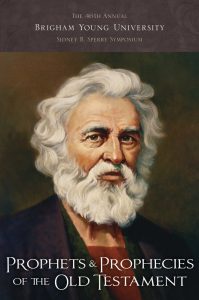Title: Prophets and Prophecies of the Old Testament
Editors: Aaron P. Schade, Brian M. Hauglid, and Kerry Muhlestein
Publisher: Religious Studies Center BYU and Deseret Book
Genre: collection of essays—proceeds of the 46th annual Sidney B. Sperry Symposium
Year of Publication: 2017
Number of Pages: 273
Binding: cloth
ISBN13: 978-1-9443-9422-6
Price: $24.99
Reviewed by Julie J. Nichols for the Association for Mormon Letters
Mormon Gospel Doctrine teachers sometimes have a delicate charge to carry out. As Church curriculum moves toward the “Come Follow Me” mandate of “teaching in the Savior’s way,” we feel a tug-and-pull between presenting lesson manual material as directed, studying independently to answer our own questions, and allowing the Spirit to guide the direction of the class discussion. Especially for those of us who teach in well-educated wards, this can be a tricky balance to maintain. More and more of the Church population falls into this category. More and more often, class members challenge teachers to do much more than merely spout the manual’s words.
The books of scripture which are our basic texts are, we sense, much more complicated —much more interesting!–than first readings, or Seminary classes, or even well-meaning supplemental online resources, lead us to believe. Faithful and accurate information regarding how to read and interpret the scriptures demands our attention if we hope to fully appreciate and teach the richness of their meaning.
So the contents of this volume—ten essays originally given as scholarly presentations at the 46th Sidney B. Sperry Symposium “[explaining] Old Testament prophecies in their original linguistic, historical, and theological contexts’—provide a valuable tool.
Named for one of the three first scholars to study the Book of Mormon systematically (Hugh Nibley, John L. Sorenson, and Sidney B. Sperry, 1895-1977), each session of the annual symposium focuses on the curriculum for the upcoming year (in this case, the Old Testament). This volume contains a wealth of information about specific passages for those who will be teaching from this library of ancient documents, and anyone else fascinated by the source of so many New Testament and modern scriptural references. But the book also provides tools that can be applied for a host of other passages not specifically covered here.
For example, Dana M. Pike, BYU professor of ancient scripture, meticulously unpacks , a passage often quoted (like so many scriptures) without reference to its historical or textual context (“And saviours shall come up on mount Zion…”). Pike begins with an overview of the book itself, which presents a number of challenges to scholars: its precise dating is unclear, its relationship to similar passages in Jeremiah raises questions, and its form is surprisingly complex, despite its brevity. Pike discusses variants and translations. Multiple meanings can be derived from the text not only because the vocabulary words may be translated in ambivalent ways, but because the imagery can be interpreted variously according to assumptions regarding the prophet’s intentions. Finally, Pike explores the use of the phrase “saviors on mount Zion” in Latter-day Saint discourse, which most often appropriates the phrase to mean temple work for the dead. However, the original prophecy needs to be understood through the lens of its own time as a promise to the Israelites of future deliverance. “There is real value,” he says, “in understanding in its own context, just as there is value in understanding how latter-day prophets have employed the evocative language of verse 21 to teach relevant truths in this dispensation” (70).
One of the tools, then, for reading the Old Testament, is to embrace not only the often-heard interpretations made in LDS discourse, but to study the texts for their original placement in time and setting. Other tools are introduced in other essays. The keynote of the conference, given by emeritus Seventy Spencer J. Condie, notes that the Old Testament plays a crucial role in all other scriptures in its references to covenants, its introduction of symbols, and its developmental patterns. Matthew L. Bowen, assistant professor of religious education at BYU-Hawaii, discusses “onomastics,” or symbolic naming and “paronomasia,” techniques of wordplay and punning by which names of places and persons carry God’s messages of destruction and salvation. And George A. Pierce, assistant professor of ancient scripture at BYU, shows that archaeological findings and a study of geography can further identify sites specifically referred to in Micah. But all these tools establish that there is much more in each book than a cursory reading conveys. Every lesson in next year’s manual could be enhanced by using one or another of these tools appropriately.
Other essays explore the use of the Old Testament in the New Testament and in the Doctrine and Covenants (two separate essays by Nicholas J. Frederick), and in the Book of Mormon (Joseph M. Spencer). Terry Ball analyzes (“line upon line, precept upon precept…”) and Jason R. Combs looks at the “fulfillment” of . It’s perhaps no surprise, and certainly a gift, that so much space is given to Isaiah, considering its importance to Lehi in the Book of Mormon. Ball’s and Combs’s essays demonstrate in brief the quantity and quality of study each Old Testament passage deserves.
Teachers and students of the 2018 Gospel Doctrine curriculum can confidently add this volume to their list of resources through which to gain much greater understanding of the Old Testament. Specific information is here, yes. But how the information has been gathered is perhaps the more important gift. This volume from the Sperry Symposium succeeds in developing in readers an awareness of the wealth of tools available, even essential, to understand and teach the Old Testament more effectively in the year to come.


Pike unpacks Obadiah 1:21…somehow the reference was elided.